Chemistry




Greetings from Chemistry at KU. We hope this newsletter finds you well and enjoying the holiday season with family and friends. Chemistry had another spectacular year and we hope you enjoy reading about the accomplishments of our students, staff, and faculty.
This year we are very excited to welcome Associate Professor Rebecca Whelan and Assistant Professor Rachael Farber to our department. Rebecca is an analytical chemist who moved her lab from Notre Dame to expand her work on cancer biomarkers. Rachael is a physical chemist building a program to understand reactions at surfaces using ultrahigh vacuum techniques. Both are excellent scholars and even better colleagues, continuing our rich tradition of being the most collegial department on campus.
In April, we held a one-day faculty retreat to discuss all aspects of our program and develop a strategic plan going forward.
At the suggestion of Prof. Lisa McElweeWhite (alumni board member), we tried something new and invited Wally Meyer from the business school to act as our meeting facilitator. Wally has a wealth of experience leading strategic planning sessions for large corporations and founded KU’s Entrepreneurship Program. Using tools developed to help businesses remain competitive (SWOT analysis, Gap analysis, Need-A-New-Chair analysis, etc.) we were able to focus our discussion and develop concrete action items to improve our effectiveness.
In May, we were delighted to welcome back our awards banquet after two years of COVID-forced cancellations. We take a lot of pride in our students and being able to recognize their accomplishments in-person is a welcome sign of things returning to normal. In addition to the students and their families, the celebration was attended by members of our alumni board in town for a meeting, some very
special friends of the department, and our current and emeritus faculty.
This year we also increased our efforts to form industrial partnerships. These partnerships expose our students to career opportunities, enhance their experiences in our program, and expand our capabilities in an increasingly tight budget climate. At the graduate level, Metrohm, a leading supplier of analytical instrumentation, generously sponsored one of our summer scholars – Chase Stucky. The summer scholars program enables talented graduate students to focus on their research over the summer by providing a generous stipend. Metrohm will be hosting Chase at Pittcon in March, where he will help publicize our partnership. At the undergraduate level, we are currently completing an agreement with Shimadzu Instruments to help sponsor our instrumentation laboratory. We are very excited to partner with Shimadzu to upgrade and maintain our undergrad labs with state-of-the-art instrumentation. These relationships benefit our partners, students, and program. We are very keen to expand these ties and strongly encourage you to contact us if you are interested in exploring similar opportunities.
Finally, my term as Chair ends next year and a new Chair will take over on July 1st. It has been a real honor to serve the department during some very “interesting” times. I appreciate the faculty’s support and the kind words of encouragement I receive from our amazing emeritus faculty. I am indebted to the Associate Chairs, Jon Tunge and Dave Benson, whose experience and competence kept the department on track; and thank former Chair Brian Laird for his sage advice and sympathetic ear. You won’t meet a finer group of students, staff, and faculty. Rock Chalk Jayhawk! Sincerely, Robert C. Dunn Professor and Chair
Prof. Jon Tunge Director Graduate Studies tunge@ku.edu
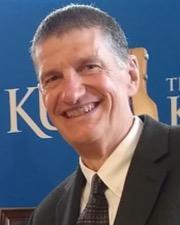
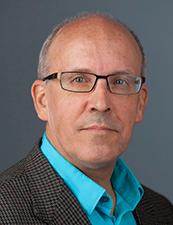

Prof. David Benson Director
Undergraduate Studies drb@ku.edu




Angie Erdley Office Manager angie.erdley@ku.edu
Lindsey Roe
Administrative Associate lindseyp@ku.edu
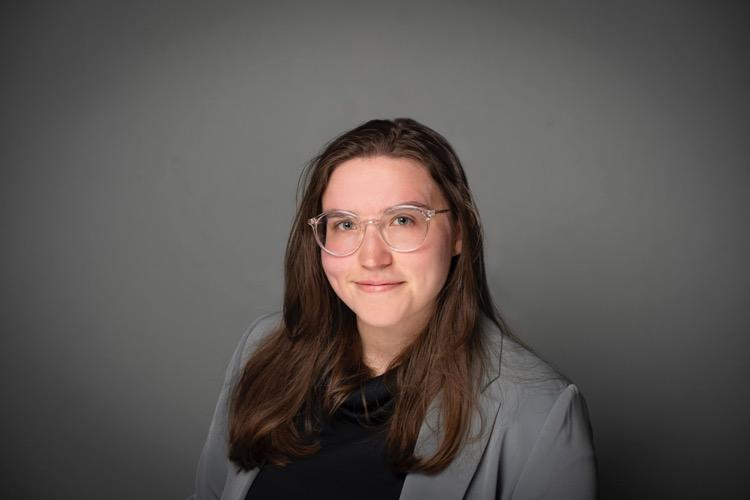
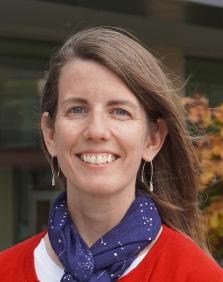
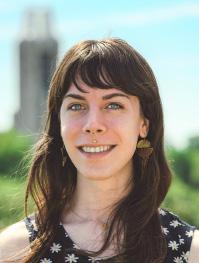
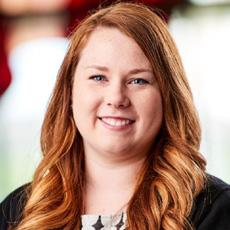
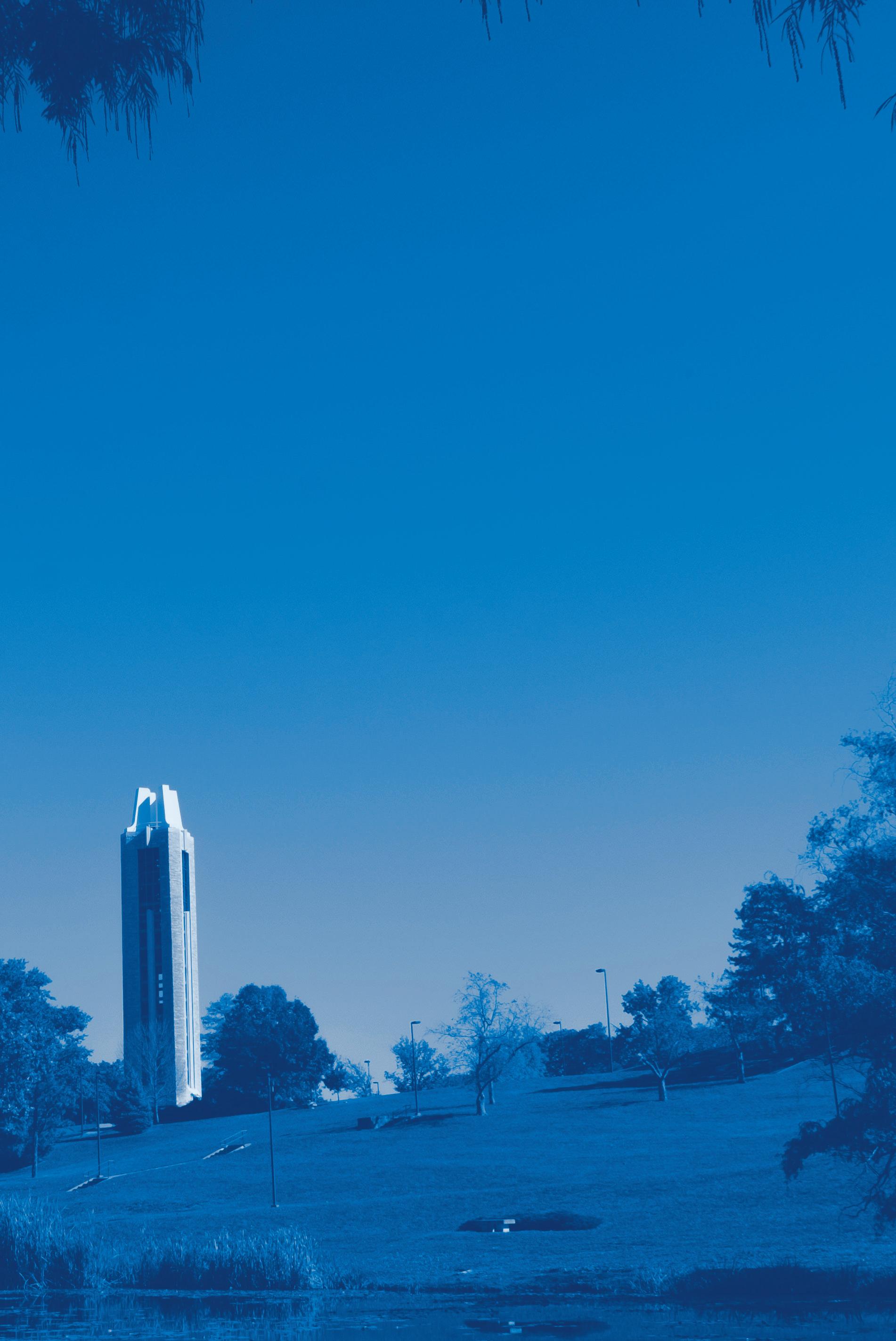
Stephanie Chamberlain Administrative Associate schamberlain@ku.edu
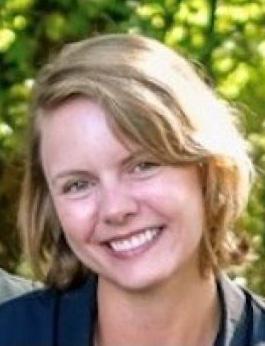

Avery Meadows Graduate Program Coordinator aimeadows@ku.edu
Deanna Beall Academic Advisor dbeall@ku.edu
Olivia Favreau
Communications Assistant ocfavreau@ku.edu




The Chemistry Department is proud to announce that Susan Lunte, Ralph N. Adams Distinguished Professor of Chemistry and Pharmaceutical Chemistry, will be the recipient of the 2023 American Chemical Society National Award in Analytical Chemistry. The award recognizes her contributions to the field of bioanalytical chemistry and, in particular, her work in the development of new separation
and detection methods for the determination of biological molecules including peptides, neurotransmitters and reactive oxygen and nitrogen species. Dr. Lunte is an innovator in the field of miniaturized separations systems involving capillary and microchip electrophoresis. This includes the development of new electrochemical detection methods and the coupling of microdialysis to electrophoresis for continuous
in vivo monitoring of drugs and neurotransmitters.



“I have been blessed with many talented graduate students, postdocs, undergraduate researchers and visiting scholars who have been part of my laboratory during my 35 years at KU. They are really the ones who have made this award possible. I have also had many great mentors and role models at KU, including my late husband, Craig.” Sue started her career at KU as a scientist in the Center for Bioanalytical Research working with Ted Kuwana. She joined the Department of Pharmaceutical Chemistry in 1995 and was appointed the Ralph N. Adams Distinguished Professor of Chemistry in 2006. She is currently the director of the Ralph N. Adams Institute for Bioanalytical Chemistry and the NIH COBRE Center for Molecular Analysis of Disease Pathways. “Sue is a leader in her field, an excellent mentor, and a phenomenal person,” said former graduate student Rachel Saylor, currently an assistant professor at Oberlin College. “Her lab has produced
many prominent analytical chemists across a wide range of careers, due in large part to the supportive, collegial, and inquisitive culture she fosters.”


It is especially notable that the late Analytical Chemistry Professor Buzz Adams received this same award in 1982. Much of her group’s work is based on some of the fundamental techniques in electrochemistry that Adams pioneered in the 1970s. Sue is an academic granddaughter of Buzz, having worked for former Adams group members Ted Kuwana and Pete Kissinger. “Buzz was an inspiration to all of us and Nancy Harmony, who edited both our manuscripts behind the scenes, is also a hidden grantee of this award.”










The news of getting selected for the Dublin City University exchange program was one of the most exciting moments of my time here at KU. I had been looking forward to applying since I first heard about the program in Dr. Benson’s freshman seminar class. This seminar also introduced me to the work of Dr. Susan Lunte, who with her late husband Dr. Craig Lunte, has had long-term collaborations with DCU throughout the years. This strong spirit of collaboration is what inspired and kept this exchange program going throughout the years. The opportunity to spend the summer at a university abroad while tackling a research problem completely new to me was a life-changing one. Knowing that the experience was made possible through generous donations to the department, such as the John Shapley Award, makes me appreciate the experience even more. The generosity of these gifts allows students to have experiences like this while being able to fully focus on research and bettering themselves as scientists.
Working in the lab of Dr. Sue Lunte throughout my time at KU has been an amazing introduction to the world of microfluidics research. My time at



DCU introduced me to centrifugal microfluidics, a concept completely new to me. Compact discs are cheaply and easily manufactured with microfluidic channels that can accomplish a variety of biological assays and other functions. Fluid is moved through these discs by spinning them at varying frequencies depending on the desired effect. This
My work in the lab of Dr. David Kinahan focused on designing a heating block and housing components to carry out convective polymerase chain reaction (PCR) on a disc. Working with Dr. Kinahan, an engineering professor, taught me 3D modeling, a skill new to me and one I believe will be useful throughout my career. With the help of Ana Barcenilla, a student of Télécom Physique Strasbourg, a complete mockup of the system was created. Future work of the project will be to manufacture the components and ensure the design is successful at maintaining the temperatures needed for PCR. The opportunity to spend a summer learning new skills while being in global city like Dublin has boosted my confidence as a researcher and has left me with connections that I know I can rely on for the rest of my career. I hope all chemistry students recognize how this summer research abroad will change their life and consider applying for 2023!
Top (L to R); Dublin street; Library at Trinity College; Dr. Blánaid White, Riley, and Dr. James Landers; Bottom (L to R) Riley; Gates to Guinness Brewery; Cliffs of Moher.

the lab of Richard Zare. As a graduate student, Rebecca’s main research interest was employing biological recognition and amplification to develop novel detectors for microscale separations. She demonstrated the use of single-cell biosensor detectors in capillaries and microfluidic devices and innovated the use of a miniaturized surface plasmon resonance spectrometer as a separations detector. She also spearheaded the creation of


the Stanford Chemistry Department’s Writing in the Majors course. For this curricular development work and her contributions as a teaching assistant and head teaching assistant, Rebecca was awarded the Walter J. Gores Award, Stanford’s highest honor recognizing excellence in teaching. Her postdoctoral training was completed with Robert Kennedy at the University of Michigan Department of Chemistry, where she built an instrument coupling capillary electrophoresis with laser-induced fluorescence anisotropy detection and used this instrument to study cell signaling mediated by G-proteins and G-protein coupled receptors. The first 14 years of her independent career were spent at Oberlin College, a liberal arts institution in northeast Ohio, where she established a research program focused on structurally characterizing ovarian cancer biomarkers and developing new affinity reagents to detect these markers. Undergraduate researchers were central to Rebecca’s research during this time, since Oberlin does not have a graduate school. While at Oberlin, she trained and mentored 69 undergraduate students, 33 of whom appear as co-authors on peer-reviewed publications. The Whelan lab’s research was supported by competitive grant funding from the Dreyfus Foundation, Research Corporation, the Society for Analytical Chemists of Pittsburgh, and the National Cancer Institute. Rebecca enjoyed teaching general,
analytical, and bioanalytical chemistry and contributing to Oberlin’s First-Year Seminar Program with a course called “Marie Curie’s Legacy: Radium Girls and Glowing Matter.” During her last four years at Oberlin, she served as Chair of the Department of Chemistry and Biochemistry. Rebecca then spent four years as Associate Professor of Chemistry and Biochemistry at the University of Notre Dame, where she expanded her research into mass spectrometry proteomics and the analysis of authentic patient samples. In July 2022, Rebecca moved to KU along with three devoted graduate students. Being affiliated with the Ralph N. Adams Institute for Bioanalytical Chemistry is a dream come true for Rebecca: the innovative research conducted in the KU Chemistry Department—past and present—has been an inspiration since her days as a graduate student. This excitement is amplified by the access to truly world-class resources and potential for collaborations on the Lawrence campus and through the KU Cancer Center. Rebecca is looking forward to continuing to teach, train, and mentor students, employing her diverse bioanalytical skill set to address important issues in women’s health. She has moved into a house on the southeast side of Lawrence and is having a great time getting to know her new hometown.

he summer exchange student representing DCU this summer was Jamie Somers, who worked in the lab of Prof. Chris Elles to measure the ultrafast dynamics of a molecular switch. Although Jamie has previously worked with nanosecond lasers in his research back home in Ireland, it was an entirely new experience for
him to work with femtosecond lasers in the Elles group. Working with KU graduate student Dan Johnson, Jamie used ultrafast spectroscopy to monitor some of the fastest events responsible for the photochemistry of the molecular switch, and even helped identify new timescales involved in the reaction.
Jamie is shown in the photo sporting a KU sweatshirt while he works on the laser. He wore a lot of KU and other Kansas-related gear this summer after the airline lost his luggage on the way here.




cholesterol levels in cell membranes. In addition to her developing interest in research, she had always had a passion for teaching and had several inspirational professors during her time at CWRU. With this in mind, she started looking into Chemistry Ph.D. programs towards the end of her time at CWRU that emphasized excellence in both teaching and research.
frequency (SRF) materials growth using UHV surface science techniques. This work studying the nano-scale growth behavior of SRF materials, such as Niobium (Nb) hydrides and Nb alloys, contributes to the implementation of next-generation SRF cavities for particle accelerators and light sources.

in both science and music. While applying to colleges, Rachael decided to pursue her interests in teaching and music and enrolled at Case Western Reserve University (CWRU) as a dual Music Education and Art History major. During her second semester at CWRU, she realized she missed the Sciences being a central part of her life. She switched her major to Chemistry in the beginning of her sophomore year at CWRU and joined the research group of Prof. James Burgess in the Spring of 2011. In the Burgess Group, Rachael used electrochemistry to study methods to increase myoglobin detection limits in blood samples as well as measure
After graduating from CWRU with a Chemistry B.S. in 2013, she enrolled in the Chemistry Ph.D. program at Loyola University Chicago. In Fall 2013, she joined the experimental physical chemistry group of Prof. Dan Killelea; the Killelea Group leverages ultra-high vacuum (UHV) surface science techniques to elucidate the surface-mediated reaction mechanisms occurring during heterogeneously catalyzed chemical transformations. Her doctoral work focused on investigating the structural and chemical consequences of dissolved oxygen species on catalytically relevant single metal crystals as well as understanding small-molecule interactions with surface defects. Following her Ph.D. studies, Rachael joined the group of Prof. Steve Sibener at the University of Chicago as a Kadanoff-Rice Postdoctoral Fellow. In the Sibener Group, she was a member of the Center for Bright Beams, an NSF Science and Technology Center, and investigated next-generation superconducting radio

Born in Iowa, raised in Kansas City, Jason completed his B.S. degree at the University of Missouri – Kansas City in Chemistry in 2012. He then attended KU for graduate school and worked with Prof. Misha Barybin in the study of asymmetrically functionalized azulene scaffolds with applications in molecular electronics. After completing his PhD in

At the conclusion of her postdoctoral work, Rachael moved to Lawrence, KS to start her position as an Assistant Professor in the Department of Chemistry at KU in August 2022. Rachael is excited to be a part of the KU community and to work with faculty and students in the Department of Chemistry and the Center for Environmentally Beneficial Catalysis advancing the field of heterogeneous catalysis. Research in the Farber Group utilizes UHV science and technology to determine the atomistic reaction pathways of chemical transformations over complex heterogeneous catalyst surfaces. In preparing representative model catalyst surfaces that capture the chemical and structural complexity of actual heterogeneous catalysts, the work done in the Farber Group will contribute to the development of nextgeneration heterogeneous catalysts with high product selectivity and prolonged catalyst lifetimes. This is a crucial step leading to the efficient, and less wasteful, production of chemical goods used across many sectors of our lives.
2019, he acquired an assistant professorship at Emporia State University, where he taught general and inorganic chemistry course se quences for three years. With nearly 10 years of experience teaching general chemistry labs and a desire to return to the KU community, he was elated to see the General Chemistry Lab Director position come available. Jason carries a wealth of firsthand experience in KU’s gen eral chemistry labs and a drive to move our labs forward in new and more innovative ways.
BACK ROW (L to R): Chase Stucky (Metrohm Scholar), Taylor Parsons (Berger Scholar), James Martinez (Higuchi Scholar), Miyuru De Silva (Lee Scholar), Chad Vietz (Berger Scholar), Rafael Hernandez (Landgrebe Scholar), Ebbin Joseph (Lee Scholar), Georgii Griaznov (Berger Scholar), Kasun Wekasinghe (Landgrebe Scholar), Ashley Borkowski (Berger Scholar).
FRONT ROW (L to R): Dimuthu Vithanage (Landgrebe Scholar), Piyanka Hettiarachchi (Berger Scholar), Riddhi Golwankar (Landgrebe Scholar), Priya Singh (Schowen Scholar), Elizabeth Grotemeyer (Lee Scholar).
NOT PICTURED: Kristen Burns (Berger Scholar), Alex Meier (Schowen Scholar), Prabhavie Opallage (Berger Scholar), Dhanushka Weerasekara (Berger Scholar), Jenna Williams (Higuchi Scholar).
The Summer Scholars program began in 2021 with the goal of supporting the research mission of the Department. The program recognizes talented graduate students by providing a generous stipend over the summer to support their research efforts. The summer months can strain research budgets since there are very few graduate teaching positions. In the fall and spring semesters, for example, the Department requires approximately 60 graduate teaching assistants per semester
to support our teaching mission. This number drops to about 5 in the summer given the limited class offerings. This results in almost 100 graduate students that need to be supported on research grants.
The selection of Summer Scholars is merit based and not influenced by funding concerns. With tuition, fees, and stipend, each scholar requires approximately $10,000 in support; so even in groups with substantial funding, this frees up precious resources that can

be used to expand the research program.


Going forward, we are expanding this program to include more students and to provide travel funds to support student presentations at national meetings.
Thanks to your generosity, we were able to grow the program from supporting 14 students in 2021 to 20 students in 2022. This includes one corporate sponsorship from Metrohm, highlighted later. We take a lot of pride in our students and thank everyone whose contributions made this program possible. Rock Chalk!


ngie Erdley joined the Chemistry Department in November 2022 as the Office Manager. She is originally from Hiawatha, Kansas and moved to Lawrence in 2010. She earned a B.S. in Journalism in 2012 and a Graduate Certificate in Professional Workplace Communication in 2020, both from the University of Kansas. Angie is also a proud graduate of the KU Public Management Center’s Emerging Leaders Academy. Most recently, Angie was the Director of Events and Student Affairs at the Robert J. Dole Institute of Politics, where she managed logistics and planning for the Institute’s public programming. She also worked closely
with the student advisory board and was nominated for Student Organization Advisor of the Year in 2020. Outside of work, Angie enjoys playing with her recreational volleyball and kickball teams and spending time with her husband, Talon, and their daughter, Veda, who will be 2 in January. You can often find them downtown seeing live music, getting ice cream at Sylas and Maddy’s or walking their dogs, Gabby and Chico. Angie is proud to be part of the Chemistry Department and looks forward to working with the staff, faculty and students.

Thanks to your support, we proudly present:
Degrees (Spring, 2022)

Jasper Ables, B.A. Avery Allin, B.S. Katherine Armstrong, B.S. Jessica Bair, B.S. Anton Barybin, B.S. Amanda Binger, B.A. Laurie Bush (December 2021), B.A. Robert Castaneda, B.A. Stephanie Castillo, B.A. Emma Cosner, B.S. Anh-Dao Do, B.A. Benjamin Fuller, B.S. Yoon Jeong, B.A. Samuel Keitges, B.S. Isabelle Krasnesky (12/21), B.A. Junnan Lopez, B.A. Christian McCoy, B.S. Carolyne Muriu, B.A. Hunter Schneider, B.A. Jonah Stiel, B.S. Leslie Vega, B.A. Rachel Walton, B.S. Julia White, B.A. Ambrosee Wilkinson, B.A.
NSF Graduate Research Fellowships
Anton Barybin Emma Cosner Rise Fellow
Jonah Stiel KU Class of 1913 Award
Emma Cosner Landgrebe Summer Scholars
Eleazar Abraham Brian Faintich Bricker Summer ChemScholars Stanslaus Kariuki Armina Raheel
Ilia Parish
Cecilia ParanjothiBricker ChemScholars Brian Faintich
Trisha Nair
Tommy Nguyen Maria Matulis
Kansas ChemScholars
Anton Barybin Emma Cosner
Jonah Stiel Udall Scholarship Nominee
Claire Dopp Undergrad Research Awards
Liz Arends
Eleazar Abraham 2022 Milennium Fellowship
Eleazar Abraham
2023 ACS Award in Analytical Chemistry
Sue Lunte
2022 Ralph N. Adams Award
Steve Soper
ACS-PRF Award Aaron Teator
Promotion to Full Professor Cindy Berrie Christopher Elles
3M Non-Tenured Faculty Award Aaron Teator
Sabbaticals
Timothy Jackson Michael Johnson James Blakemore
Irvin Youngberg Award in Applied Sciences
Steve Soper
COBRE-CMADP $5.7 million phase three award

Sue Lunte
NIH-P41 Award Steve Soper
New Faculty Graduate Research Fund Award at KU
Meredith Hartley
Best of Lawrence: Teacher at KU Shuai Sun
60-Year Membership Recognition - ACS Richard Givens Richard Schowen George Wilson
Degrees (2021 - 2022)
Uditha Athapattu, Ph.D.
Ty Balduf, Ph.D.
Galina Bulgakova, Ph.D. Kristen Burns, Ph.D.
Chelsea Comadoll, Ph.D.
Chamalee Demalgiriya Gamage, Ph.D. Gihan Dissanayake, Ph.D.
Kiersten Garcia, Ph.D. Elizabeth Grotemeyer, Ph.D. Wade Henke, Ph.D. Yuri Lee, Ph.D.
Julie Leseberg, Ph.D. Jaycee Mayfield, M.S. Alex Meier, Ph.D. Isaac Moore, M.S. Abraham Opalade, Ph.D. Juan Rincon Pabon, Ph.D. Leah Pfeifer, M.S.
Chathurika Rathnayaka, Ph.D. Yuqi Shi, Ph.D.
Chase Stucky, Ph.D.
Sachindra Thippala Gamage, Ph.D. Dimuthu Vithanage, Ph.D. Mihiri Weerasinghe, Ph.D.
NIH Chemical Biology Training Grant Program
Hayley Blockinger Esther Holt Jacob Theismann Matthew Zupan
Aleesa Chua (2022-2026) Madeline Isom (2021-2025) Patrick Connelly (2020-2024) Shaun Kelsey (2019-2023) Michael Wrigley (2018-2022)

Justin Jankunas Award - American Physical Society (Best Dissertation in Chemical Physics)
Dr. Zeke Piskulich
Marnie & Bill Argersinger AwardOutstanding Doctoral Dissertation in STEM
Dr. Zeke Piskulich


Collaborative projects combine the diverse expertise from multiple labs to tackle grand research challenges. In January of 2020, Prof. Tim Jackson and his lab started a collaborative project with Dr. Carole Duboc and Dr. Marcello Gennari at the Université Grenoble Alpes. This collaboration combined the Jackson Lab’s expertise in kinetic methods, spec troscopy, and electronic structure computations with expertise in synthesis and electrocataly sis from the Duboc and Gennari Labs. The goal of the project was to develop new catalysts for oxygen reduction that use earth-abundant met als such as Fe, Mn, and Co. Such catalysts could serve as relatively inexpensive materials in fuel cells. More over, detailed studies of homoge neous catalysts can provide insight into the complicated steps involved in oxygen reduction, a multi-electron, multi-proton process, which could aid in the design of more efficient catalysts. While this international collaboration was off to a great start, something happened in March of 2020 that considerably slowed down the research efforts! Labs were closed (for a time). The faculty involved in this project had to learn how to teach and mentor students online. There were significant disruptions
in obtaining supplies needed for this work. These and other challenges might be enough to destroy any collaboration!
To reboot this promising project, Tim spent a portion of his sabbatical in spring of 2022 as a Visiting Professor at the Université Grenoble Alpes. Grenoble, often called the capital of the Alps,


early observations made in 2020. From this new work, it was determined that a pair of structurally similar manganese and cobalt complexes have different electrochemical reactivities with oxygen. While the manganese complex only reduces oxygen by two electrons, generating hydrogen peroxide, the cobalt complex performs the complete, four-electron reduction of oxygen to water. Tim’s lab at KU is currently performing electronic structure computations to understand the reason for this difference in reactivity.
is a city of about 700,000 situated in the southeast of France. In addition to containing the Université Grenoble Alpes (one of the top Universities in France for STEM), Grenoble is also home to one of the largest labs of the French Alternative Energies and Atomic Energy Commission (CEA). Tim spent most of his sabbatical working in the Department of Molecular Chemistry with Dr. Duboc, Dr. Gennari, and their research groups. This team revisited some of the
In addition to these research activities, Tim gave presentations about his research at KU to faculty and students in France. He was the plenary speaker at a half-day symposium, and he gave an invited talk at the CEA Grenoble Center. In addition to being a science and technology hub, Grenoble is also known for its food, which is heavily influenced by Italian cuisine (Tim stayed on a street with no fewer than ten pizzerias!). As the capital of the Alps, Grenoble also boasts a plethora of outdoor activities. The weekends and French holidays presented Tim with opportunities for long hikes and bike rides. Sabbaticals come only once every seven years, so it’s wise to make the most of them!

The COBRE Center for Molecular Analysis of Disease Pathways (CMADP) at KU has been awarded a third and final 5-year, $5.7 million federal grant to sustain the collaborative, multidisciplinary research environment and infrastructure at KU through its research core laboratories and pilot project programs for faculty investigators. Led by director Susan Lunte, CMADP mentors earlier-career faculty researchers and provides stateof-the-art technologies through its three core labs. Its goal is to create enabling technologies, new techniques and methods that allow researchers to study diseases in novel ways and develop new therapeutics to a range of illnesses including heart and lung diseases, cancers, and neurological diseases. CMADP’s three core lab facilities are the KU (Ralph N. Adams) Nanofabrication Facility, Synthetic Chemical Biology Core and Genome Sequencing Core. Since CMADP’s in-
ception in 2012, these facilities have supported over 600 researchers and have been cited in more than 200 publications authored by CMADP core lab users. While there are no fourth phases in the COBRE grant system, CMADP plans to use the final round of funding to ensure each core lab remains self-sustaining through expanding their user bases. In the decade since receiving the Phase 1 COBRE award, 24 junior faculty researchers supported by CMADP have brought in over $40.5 million in external funding to KU. Thus far, CMADP has provided research/pilot project awards and contributions to new hire start-up packages for 7 KU Chemistry faculty members, including Meredith Hartley, Mike Johnson, Aaron Teator and Rebecca Whelan.
NIH Center of Biomedical Research Excellence

folding of peptides as well as organic synthesis using peptide-sandwiched mesohemes. This research resulted in Brad’s first peer-reviewed publication, one he keeps in his office to this day. In addition to the research, Brad said the faculty, graduate students, and fellow undergrads really gave the department the feeling of family. When asked about how his undergraduate research experi ence at KU shaped his future path, Brad said that it: “… opened my eyes to the world of chemistry beyond the class room. The idea that anyone willing to ask hard questions and put in the work could have an impact really set me on a course for a career focused on find ing and applying technical solutions to challenging real-world problems.”
Dr. Brad Hart, who graduated from KU with a B.S. in Chemistry in 1996, currently heads the Intelligence Program (also known as Z Program) at Lawrence Livermore National Laboratory. Brad grew up in Garden City, Kansas in the southwest corner of the state. He started college with the goal of pursuing a pre-med curriculum, however he quickly discovered a passion for chemistry, which was strengthened when he became engaged in research in Professor David Benson’s lab at KU. “Professor Benson was a new
A key part of his undergraduate edu cation was spending a summer conduct ing research in Professor Gilbert Stork’s lab at Columbia University as part of the NSF/REU program. “Working in Professor Stork’s lab was an incredible opportunity that I took so much away

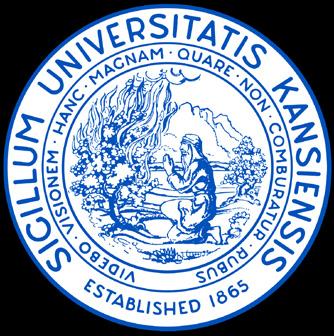
“Great sense of humor as well as a sense of adventure (in addition to being the first group member of an assistant professor, he took up skydiving and earned a pilot’s license in college). But humble, congenial and hard-working at the same time.”
-Prof. Daviding with Professor Rowland about our common ties and shared love of KU.”
After graduate school Brad chose to stay in California as a Post Doc at the Lawrence Livermore National Laboratory (LLNL), a Department of Energy Laboratory in Livermore California. During that time, he began work within the Fo


Benson
from. The experience really helped shape my remaining time at KU as well as my path to graduate school.” After graduating from KU, Brad went on to the University of California, Irvine, where he earned his Ph.D. under Professor Kenneth Shea. While exploring organic synthesis and materials chemistry at UCI, Brad also had the opportunity to meet and engage with another faculty member, Professor F. Sherwood Rowland, winner of the 1995 Nobel Prize in Chemistry and former Professor at KU. “While I didn’t have the honor of work-
ses, as well as novel approaches to traditional forensics. In addition, the FSC is a working forensic laboratory supporting law enforcement, the national security community and the Department of Defense. Additionally, the FSC serves as one of only two laboratories in the United States that are designated as Organization for the Prohibition of Chemical Weapons (OPCW) Laboratories, that is internationally certified under the Chemical Weapons Convention for identifying chemical-warfare agents. It was during his time at the FSC that Brad found a passion for science in the national interest.
His time in the FSC drew out a desire to contribute in a more hands-on way to issues surrounding national security and in 2008 he jumped at an opportunity to join the Defense Intelligence Agency (DIA), where he was involved in supporting the agency’s mission both in the US and abroad. In 2011 Brad found himself headed back to LLNL, this time



KU Chemistry with the iconic TV show, The Simpsons. The connection runs through Professor Hamilton P. Cady (1874-1943), who began his career as an assistant professor at KU in 1899 (top photo). That’s beforehe received his Ph.D. That came in 1903 with research on the electrical conductivity of salts in liquid ammonia, the first Ph.D. degree conferred by the KU Chemistry Department. Although Cady is most famous for his discovery of helium in natural gas with David McFarland in 1905, perhaps his most remarkable achievement was his longevity as chair of the department, a position he held from 1920 to 1940.
Among H.P. Cady’s graduate students was one Abe A. Groening (bottom photo), who received a Ph.D. in 1926 with a dissertation entitled Decomposition Voltages and Metal Overvoltages in Liquid Ammonia and in Water . The work was published in the Journal of Physical Chemistry (1926, 30, 1597-1615).
Abe Groening’s full name was Abram Abraham Groening, which he often shortened to A.A. Groening. A.A. was born in Hillsboro, Kansas in 1894 into a community of Mennonite immigrants. He was part of the 1908 inaugural class at Tabor College, a Mennonite college in Hillsboro, where he first completed his secondary school and then received his B.A. in 1915.

Groening’s Mennonite community was German speaking by heritage and pacifist by conviction. In 1918 A.A. received his draft notice. Like many young Mennonite men, many of them conscientious objectors, A.A. was to report to Camp Funston at Fort Riley, Kansas. Whether he made it to Camp Funston or not is not clear. Anti-German and antipacifist sentiment ran deep during World War I., and at some point A.A. moved to Saskatchewan, Canada. According to local lore in Hillsboro, A.A. left Kansas to escape anti-pacifist vigilantes. A.A.’s second son, Homer Philip Groening, was born in Saskatchewan in 1919.

A.A. returned to the U.S. and received an M.A. degree from the University of Oregon in 1921, after which he took a position as instructor of chemistry and physics at Tabor College. Sometime around 1923 he arrived


1926 he continued to teach at Tabor where, by 1930, he was dean.
In 1930, A.A. left Tabor College to join the faculty at Albany College in Oregon. Apparently an able administrator, A.A. was appointed dean at Albany College in 1935. The college later relocated to Portland and took the name Lewis and Clark College. After a stint at Linwood College, A.A. returned to Lewis and Clark as head of the physics department. A.A.’s son Homer married Margaret Ruth Wiggum in 1942. Homer and Margaret (Marge?) had several children, among them Matthew Abram Groening, born in Portland in 1954.
And that brings us to the Simpsons. After college, Matt Groening moved to Los Angeles, where he worked odd jobs, started a comic strip, and eventually The Simpsons. Bart Simpson’s parents, Homer and Marge, were named after Matt Groening’s parents Homer and Margaret Groening. Like Bart in the comic, Matt had younger sisters Elizabeth (Lisa) and Margaret (Maggie).


Perhaps the fact that Matt Groening’s grandfather was a chemist explains the frequent references to chemistry on the show, including a periodic table with 250 elements and Homer’s rescue of Lisa from a snowbound school by (accidentally) tipping over a silo of salt to melt the snow. My favorite is Lisa’s perpetual motion machine, prompting Homer Simpson to respond, “In this house we obey the laws of thermodynamics!”
Maybe Matt Groening should have taken a chemistry class from his grandfather: when Bart Simpson mixes acid with base the result is an explosion that covers everyone in the room with green gunk. D’oh!
Acknowledgements: The connection between KU chemistry and A.A. Groening is particularly interesting to me. I also grew up in Hillsboro, Kansas and attended Tabor College, where my father was a chemistry professor. I thank Peggy Goertzen, Director of the Center for Mennonite Brethren Studies at Tabor College, for providing details of A.A. Groening’s career at Tabor. A.A. Groening’s dissertation was accessed through the K.U. libraries. Further information was found in Dale Suderman, Hillsboro,HomeoftheSimpsons(Hillsboro Free Press, Aug. 15, 2007); A.A. Groening’s obituary (TheOregonian, Feb. 21, 1981); and J.A. Wiebe, V.R. Wiebe, and R.F. Wiebe, The Groening/WiebeFamily1768-1974.



I started life in Burdett, Kansas, population, 200. My parents were high school teachers –my mom taught English, and my dad taught Physical Education. Eventually, Dad gave up his gym shoes and went into sales. As a result, we moved first to California, then Ohio. As a high school student in Ashland, Ohio, I enjoyed my math classes but did not immediately fall in love with chemistry. I was, on more than one occasion, moved to the back of the classroom for talking too much and distracting my fellow classmates. My chemistry teacher even sent me to the principal’s office once for violating the dress code because I had worn shorts to school.
After such an inauspicious start in my eventual field, I had a lucky break, thanks to the principal of the elementary school where my mother was teaching at the time. Principal Mark suggested I join his daughter, who was also a high school student, and take the Honors General Chemistry class at Ashland University during my senior year. This second experience with chemistry was much more enjoyable, as the ideas of chemistry came to life; and thinking, not memorizing, was the currency of the classroom. This class inspired me to become a chemistry major in
college, and eventually, a professor.
I attended Grinnell College in Grinnell, Iowa for my undergraduate studies. In addition to learning a lot of chemistry there, I learned how much an engaged professor could positively influence students. After a decentbut-not-impressive first semester in college, my academic advisor and organic chemistry professor, Mary Mader, told me that I needed higher grades if I wanted to get into top graduate schools. This advice was not only absolutely accurate, it provided the motivation and encouragement necessary to realize that such a path was possible, with a little more effort. In addition to being hard on me when I needed it, Professor Mader also helped me land a full-tuition scholarship covering my last two years at Grinnell; these funds made such a difference. They likely kept me from having to transfer to a more affordable school.

I did a number of different summer research stints as an undergrad. I spent a summer at Harvey Mudd college, where, at the time, men outnumbered women by about 10 to 1. I struggled through a summer of synthetic chemistry in Laramie, Wyoming, where I thankfully learned that synthesis was not my thing. Finally, I spent a summer at Kimberly Clark in Neenah, Wisconsin, where
my goal for the summer was to develop better ways to test the absorbency of diapers.
In 1997, I moved to Oakland, CA, to attend graduate school at the University of California, Berkeley. Even back then, Berkeley had student housing problems. I eventually found a very convenient studio apartment that was less than a block away from the following amenities: a gun store, a liquor store, an hourly motel, a funeral parlor, a church, and the subway (BART) station. Of all the luxurious amenities mentioned, the BART station was the only one I ever entered.
I began doing mass spectrometry research on carbohydrates under the guidance of Professor Julie Leary. Two things immediately attracted me to this line of work: First, it was fascinating that one could use an instrument designed to weigh things (the mass spectrometer) to distinguish diastereomers, molecules with the same weight and functional groups. The second highly appealing aspect of the work was that mass spectrometers are so sensitive, the samples to be analyzed always were prepared and loaded into new (disposable) Eppendorf tubes – this meant that there was no dishwashing to be done, a point that clearly established
Dr. Heather DesaireI applied for my faculty position at the University of Kansas while I was finishing up my graduate studies. I am immensely grateful that the faculty at KU could see past my lack of experience and that they offered me a job. I spent about seven months, between the completion of my graduate studies and the start of my position at KU, working at a contract research organization in Kansas City that specialized in supporting the pharmaceutical industry.

Figuring out how to obtain grant funding proved to be quite challenging for me, as it is for most new professors. It took me 10 tries at submitting external grant proposals before I got one funded. The winning proposal described analyses of glycosylation on HIV vaccine candidates. This line of work opened up opportunities for my group to collaborate with the preeminent HIV vaccine developers in the US, and these studies and collaborations have been a significant component of my research program for the past twenty years.
The initial HIV grant we received primarily described methods development work: Our main goal was to develop a robust strategy to characterize the glycans (sugar molecules) on the Env protein in a glycosylation sitespecific manner. The protein has ~30 different sites where glycans were attached, and we thought that being able to discriminate the glycans at each site would ultimately provide more useful information than cutting them all off the protein first and then analyzing them, which was the prevailing strategy at the time for glycosylation analysis of proteins. Analyzing the glycans in this site-specific approach was more challenging, though, and it took several
More recently, we were able to apply these same strategies to analyzing the glycosylation on the S glycoprotein, which is the primary component in the SARS-CoV-2 vaccine. Because we had spent years developing, testing, and validating a workflow that produces a highly reliable assessment of the glycosylation on multiply glycosylated proteins (in our HIV work), we were able to apply these same strategies to this new viral protein, which is also heavily glycosylated. In addition to characterizing the glycans on a native form of this protein, we showed that many other researchers, who were also analyzing glycosylation on the SARS-CoV-2 glycoprotein, were getting incomplete and inaccurate information. Their analyses relied on a commercial product to analyze the glycosylation from the mass spectrometry data, and we showed that this software produces more false positives than true positives and only assigns about one in three of
Research and Development.
At KU, Keith carried out undergraduate research in the labs of Profs. Givens and Christofferson and he credits this and his other experiences at KU with “...setting him on the path to a successful career.” “I have been very fortunate to work in an area that is amazingly rewarding and having an impact on patients’ lives.” Keith established the Chair to help “...pay KU back...” for setting him on his career trajectory.

As discussed in the last newsletter, The Keith D. Wilner Chair in Chemistry is a rotating Chair that will be awarded every three years to a deserving faculty member. During their 3-year term, each awardee will hold the title of the Keith D. Wilner Chair in Chemistry and receive $15,000 a year in support for their scholarly activities. When the invested endowment grows to a sufficient level, the Wilner Chair will be converted to a permanent endowed professorship and used to attract a faculty member at the Distinguished Professor level.





Tstration (CHEM DEMO) program, which started in August 2007 under the direction of Dr. Jill Headrick, serves and supports the entire Chemistry Department both inside and outside the classroom. The goal of this program is to develop and provide safe, high-quality demos that Chemistry instructors can use in their courses, teaching labs, and outreach efforts. The demonstrations are cataloged on a faculty-accessible website that includes descriptions, step-by-step procedures, photos, videos, reference materials, and a variety of supplemental instructor resources. Due to this extensive, contentrich library, Chemistry faculty have immediate access to information on hundreds of lecture demonstrations spanning many different topics and levels of instruction. Faculty wanting a demo or practice session
ery, set-up, and presentation (if preferred). These demos are designed to augment the instruction of difficult chemical concepts, stimulate active learning, encourage animated discussion, and address common misconceptions that may hinder concept mastery.


The CHEM DEMO program, which originally operated out of a storage room in Malott Hall, currently runs out of a state-of-the art prep room in the basement of Gray-Little Hall. Shortly after moving


the actual species present. In the future, we are working to simplify and automate our expert-based approach so that more groups can analyze glycosylation on important proteins and do it in an efficient way that gives the right answer.
In addition to studying glycosylation on proteins, I am also interested in combining computational power and mass spectrometry data. In this domain, we use machine learning to search for a blood-based biomarker of Alzheimer’s disease. Right now, there is no blood test that can determine whether someone has Alzheimer’s Disease. If we had such a test, it could improve early intervention for the disease and help accelerate the development of effective treatments. My group is
classrooms, have helped expand the reper toire of demos that can be conducted safely in our Chemistry courses. New facilities, upgraded classroom technologies, partnerships, and strong faculty support have helped this program thrive. This Fall, the CHEM DEMO program celebrated its 15year anniversary. Cheers to a decade and a half of making a difference and improving the overall quality of Chemistry instruction at KU. May the next 15 years be even more inspiring!
quantified hundreds of proteins and lipids in blood samples from both Alzheimer’s patients and healthy controls. We have applied machine learning strategies to these data and found something unexpected: The set of proteins from Robinson’s dataset that predicts Alzheimer’s disease accurately in White patients does a poor job of predicting Alzheimer’s disease in Black and African American patients. The Robinson lab is well known for their work in championing racially diverse sample sets, and through collaboration with them, we are continuing to work on developing a biomarker panel that accurately identifies Alzheimer’s disease for everyone.
Celebrating 15 years of excellence (and explosions!) Prof. Cindy Berrie Prof. Misha Barybin Dr. Jill Headrick and Navi
In September of 2021, we initiated the Sutton Family Research Impact Award, using an endowment fund generously established by the family. Every month a paper published by a faculty member is selected for this award. The paper is selected from all the papers published in the previous three month cycle and is selected based on impact, which is judged using many factors - the quality of the journal, editors’ highlight,
coverage elsewhere, selection for journal cover, etc. The paper is highlighted on our web page (see picture) and social media sites and the corresponding faculty member recieves a $500 cash prize. In order to be eligible, the faculty member must be the corresponding author on the paper and authorship should be shared by at least one other KU person (student, postdoc, or KU collaborator). The goals are to better
and incentivize productivity. We are very grateful to the Sutton Family whose generous support has made this program possible. Please frequent our website (www.chem.ku.edu) to keep updated on current winners!

The Johnson Research Group received the June 2022 Sutton Family Research Impact Award for their work on improving the electrochemical measurement of serotonin at microelectrodes (Stucky C and Johnson MA, J. Electrochem. Soc. 2022, 169, 4, 045501). Serotonin is a chemical in the brain that many neurons use to communicate with each other.

Alterations in how well neurons release and take up serotonin are associated with many neurological disorders,
especially anxiety and depression. Many research groups use a technique called fast-scan cyclic voltammetry at carbon-fiber microelectrodes (FSCV) to measure serotonin release and reuptake in rodents, with the goal of understanding the role that this chemical plays in these disorders. These studies often incorporate selective serotonin reuptake inhibitors (SSRIs), also known as anti-depressants. Chase Stucky, first author on this paper, tested the potential confounding effects of SSRIs on serotonin measurement with FSCV. He found that common SSRIs significantly foul electrodes, which prevents accurate measurements of serotonin over short time periods. To mitigate these fouling effects, a newly developed waveform called the Extended Serotonin Waveform (ESW) was employed. This waveform

generates a more positive charge on the microelectrode which causes the
The December 2021 Sutton Family Research Impact Award went to the Berrie group for a paper in the area of nanolithography (J. Phys. Chem. C, 2021 125, 23490-23500). The Berrie group has extensively investigated nanoscale patterning tools in order to allow fabrication of substrates with precisely tunable structures in order to assess the role of the nanoscale structure in materials properties including protein
adsorption and assembly, electrical conductivity, and friction. Many of the commonly used fabrication methods require either organic resist layers that are difficult to remove or are not suitable for commonly used substrates. In order to address this, the Berrie group recently developed patterning methods which rely on simple salt resist layers, which are readily removed from the surface by simple aqueous processing without significant residue, and can be applied to a wide range of substrates. One of the critical aspects of this work was optimizing the deposition of the salt nanoparticle film in order to achieve uniform coverage and thickness required to function as an effective resist film, but also still be thin enough to be patterned using AFM-based patterning
tools. This challenging task was carried out primarily by two graduate students who recently completed their
Ulapane (left) who is currently at Boehringer Ingelheim. Both students made it back to KU for the hooding ceremony last May where we were able to celebrate their success.

 The Cindy Berrie Research Program Sculpting surface properties at the nanometer dimension
The Cindy Berrie Research Program Sculpting surface properties at the nanometer dimension

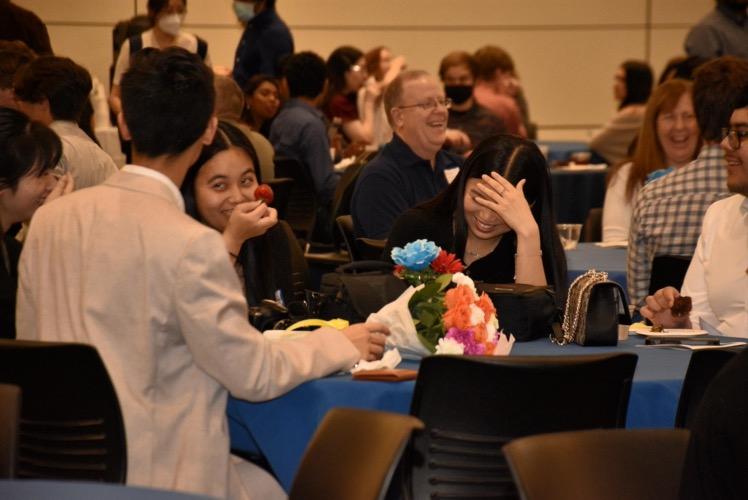

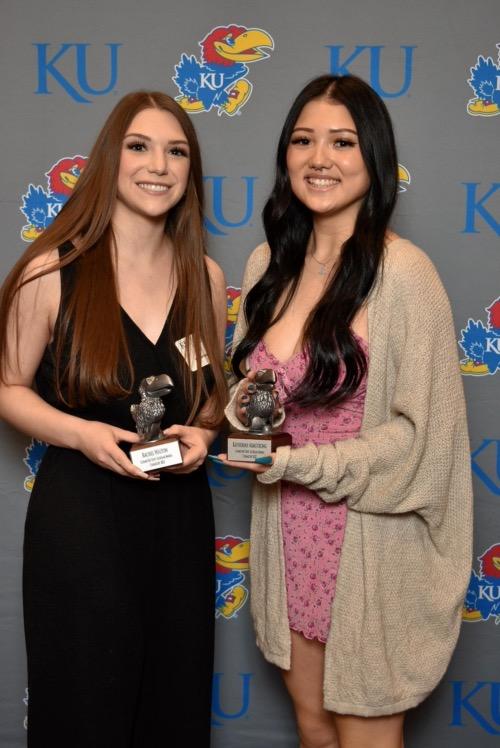
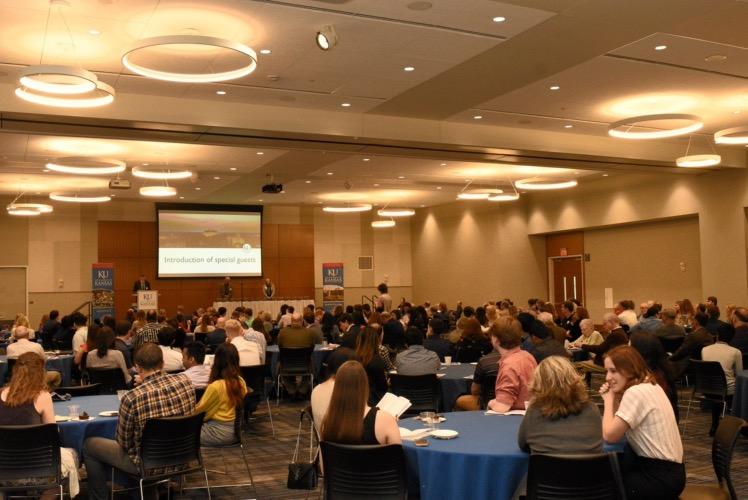

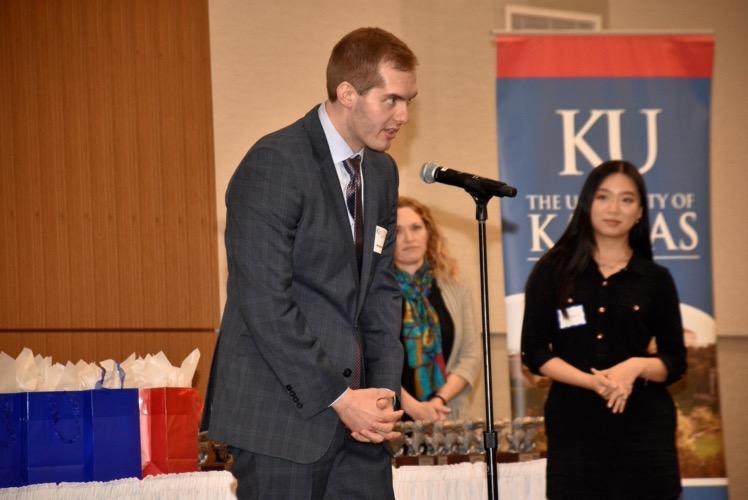

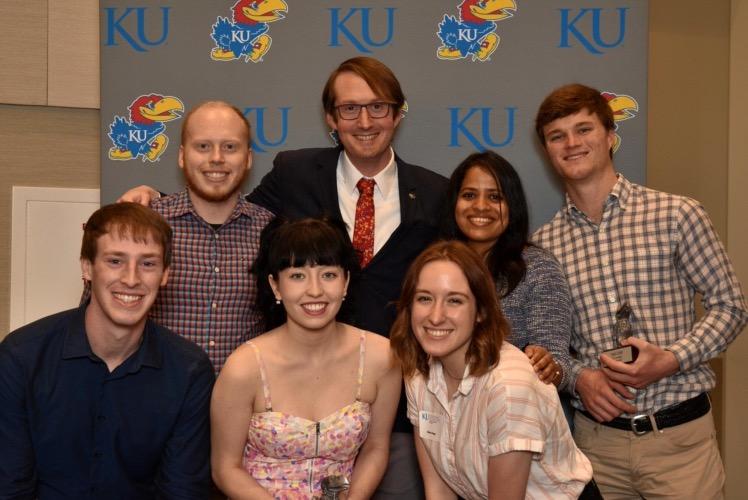


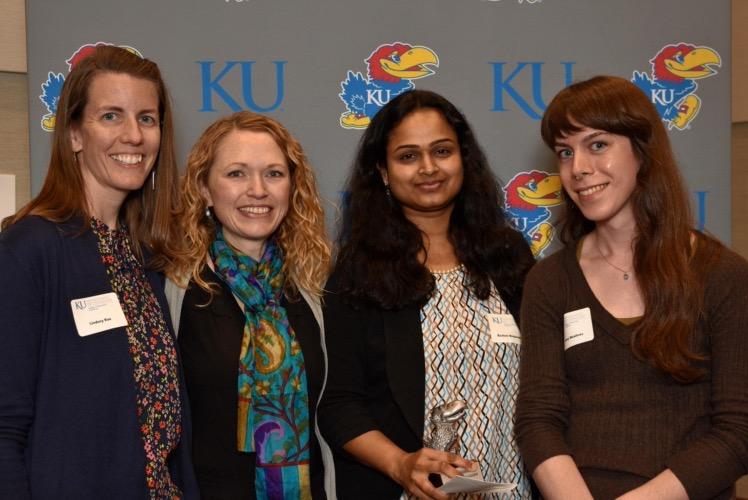
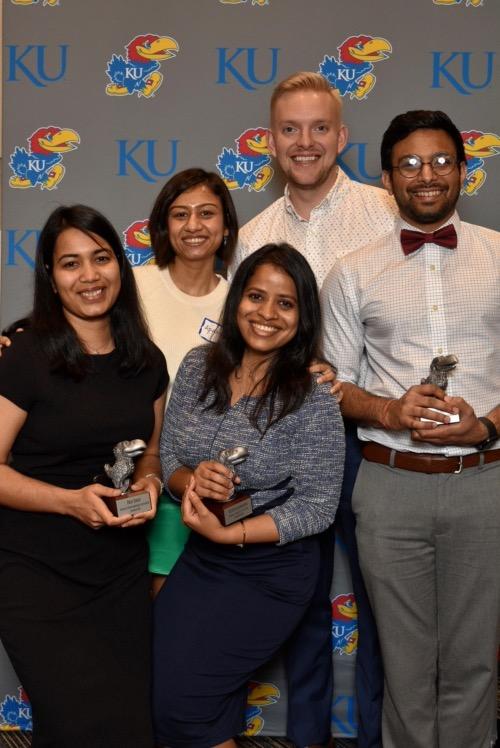

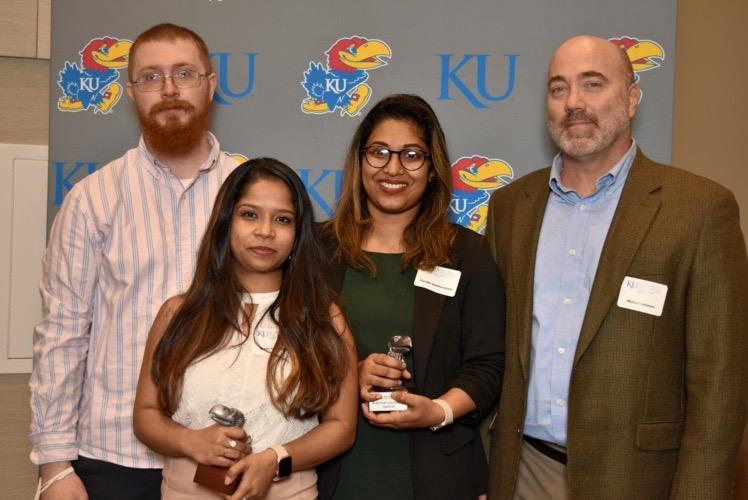

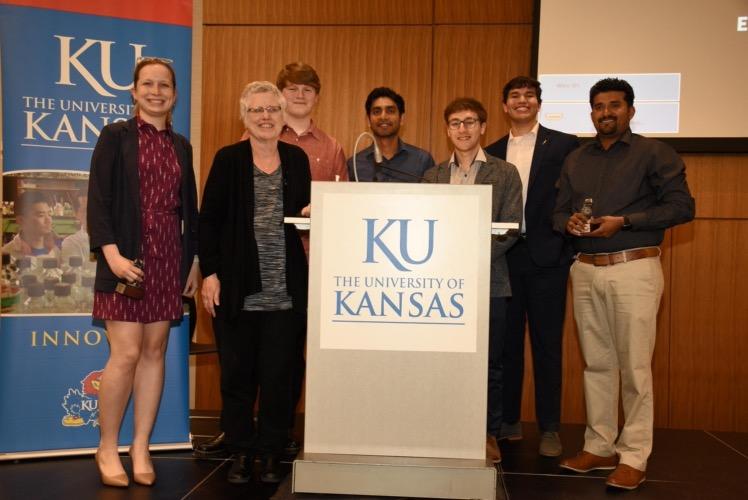
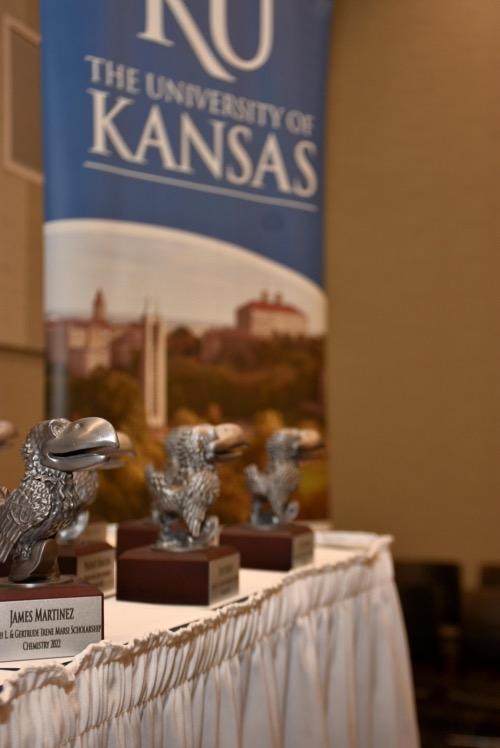
Walter Gubar Memorial Scholarship
Abbey, Joshua Brenneman, Eden Butler, Kelsey Korte, Caitlyn Wakarusa Valley ACS Section Award
Fuller, Benjamin Richard J. Bearman Chemistry Award
Cosner, Emma Ralph E. & Esther Weik Badgley Award
Yeh, Elaine Owen W. Maloney Scholarship Nair, Trisha Leonard V. Sorg Scholarship
Wolfmule, Gavin Leland & Jill Weigel Scholarship Faintich, Brian
Kristina May Paquette Scholarship & Post Beckman Scholar Award
Dopp, Claire Kristina May Paquette Scholarship Stevenson, Marcus Keith & Dona Darlington Award Bair, Jessica
The Student Awards Banquet returned in-person this May after several years of absence due to the pandemic. Students and their families, faculty, emeritus faculty, and special guests filled the spacious ballroom of the Burge Union to recognize and honor our talented undergraduate and graduate students. This year we recognized
K. Barbara Schowen Scholarship
Finn, Thomas John Shapley Award for Excellence in Research Stegmaier, Riley James P. & Sharon A. Elrod Scholarship Kussatz, Caden Jacob Kleinberg Award Abraham, Eleazar Frank Newby Physical Science Award Castaneda, Robert Castillo, Stephanie Do, Anh-Dao McCoy, Christian Wilkinson, Ambrosee
1. Rachel Walton, Katie Armstrong; 2. Kasun Wekasinghe, Stephanie Castillo, Dr. Aaron Teator;
3. Dr. Michael Johnson, Dr. Richard Givens; 4. Benjamin Fuller, Anh-Dao Do;
Frances Gayetta Hanna Lenser Scholarship
McNickle,Taryn
Rips-Goodwin, Audrey Floyd & Ruth Fassnacht Scholarship, & Kenyon Latham Award
Osborn, Jiani Chemistry Department Scholarship
Armstrong, Katherine Walton, Rachel Haenggi, Samara Todd, Kaytlin
Burton & Cheryle MacKenzie Scholarship
VandeVelde, Cole
Bijan & Mary Taylor Amini Scholarship Matulis, Maria Nguyen, Brandon American Institute of Chemists Award & Ted M. Gardiner Award Stiel, Jonah
Alpha Chi Sigma Award & Gini Adams Research Award in Analytical Chemistry
Barybin, Anton Adrienne Hiscox Mitchell Scholarship Khalife, Celine
58 undergraduates and 36 graduate students, including 49 women, 18 underrepresented minorities, and 6 first generation students. Along with our coveted Jayhawk Trophy, this year’s awardees received over $223,950 in award and scholarship support during the celebration. We also recognized our undergraduate research and Bricker ChemScholar
Jack & Carolyn Landgrebe Summer Undergraduate Research Scholarship
Abraham, Eleazar Faintich, Brian Clark E. Bricker Summer ChemScholar Award Kariuki, Stanslaus Paranjothi, Cecilia Parish, Ilia Raheel, Armina
Adrienne Hiscox Mitchell Scholarship Niyangoda, Sayuri Opallage, Prabhavie Williams, Jenna
5. Jacob Theismann, Sayuri Niyangoda, Piyanka Hettiarachchi, Dr. Michael Johnson; 6. Dr. Jon Tunge, Ebbin Joseph; 7. Dr. Glendon Cox, Dr. Keith Wilner, Karen Cox, Dr. Sriram Naganathan; 8. Prabhavie Opallage, Miyuru De Silva, Hasini Senanayake, Indika Warnakula, Dimuthu Vithanage, Dhanushka Weerasekara, Piyanka Hettiarachchi; 9. (Front row) Priya Singh, Riddhi Golwankar, Prasenjit Srivastava; 10. Dr. Bob Dunn; 11. Jonah Stiel, Alexander Ervin, Emma Cosner, Dr. James Blakemore, Claire Dopp, Riddhi Golwankar, Davis Curry; 12. Galina Bulgakova, Dr. Sue Lunte, Riley Stegmaier, Dhanushka Weerasekara, Anton Barybin, Gavin Wolfmule, Indika Warnakula; 13. Lindsey Roe, Liz Coleman, Rashmi Binjawadagi, Avery Meadows; 14. Miyuru De Silva, Dr. Bob Dunn, Prabhavie Opallage.
Bijan & Mary (Taylor) Amini Scholarship
Gamage, Sachindra Burton & Cheryle MacKenzie Scholarship
Joseph, Ebbin
Rathnayaka, Chathurika Senanayake, Hasini Singh, Priya Cornelius McCollum Research Scholarship
Srivastava, Prasenjit Weerasekara, Dhanushka Dains Memorial Scholarship
Karns, Neiley
Ernest Griswold Award in Inorganic Chemistry
Leseberg, Julie Frank B. Dains Award in Organic Chemistry
Meier, Alex Glen & Karen Cox Chemistry Scholars
Grotemeyer, Elizabeth H.P. Cady Award Curry, Davis
J.K. Lee Award in Analytical Chemistry Stucky, Chase
support recipients ($83,000) and our graduate Summer Scholars ($189,000) at this event, bringing the total student support to just under $500,000 for the year. The Chemistry Department is very fortunate to have a large network of generous friends that recognize, value, and support the hard work of these very deserving students. This event is also a tribute to your generosity – Rock Chalk!
Kenneth & Gertrude Marsi Scholarship
Binjawadagi, Rashmi De Silva, Miyuru Martinez, James Parsons, Taylor Theismann, Jacob Luther & Eleanor Hall Student Support Borkowski, Ashley Freed, Ian Paul & Helen Gilles Award in Physical Chemistry
Balduf, Ty Ray Q. Brewster Award
Griaznov, Georgii Reynold T. Iwamoto Scholarship
Golwankar, Riddhi
Steve & Susan Snyder Chemistry Award
Kurfman, Emily Zhang, Kaihua
Takeru & Aya Higuchi Award in Physical Chemistry, & Women in Chemistry Opportunity
Burns, Kristen
Takeru Higuchi Doctoral Progress Award
Henke, Wade
The George Wilson Prize
Bulgakova, Galina
The Richard & Sue Givens Scholarship
Vithanage, Dimuthu Walter and Roy Cross Memorial Fund Hettiarachchi, Piyanka Warnakula, Indika
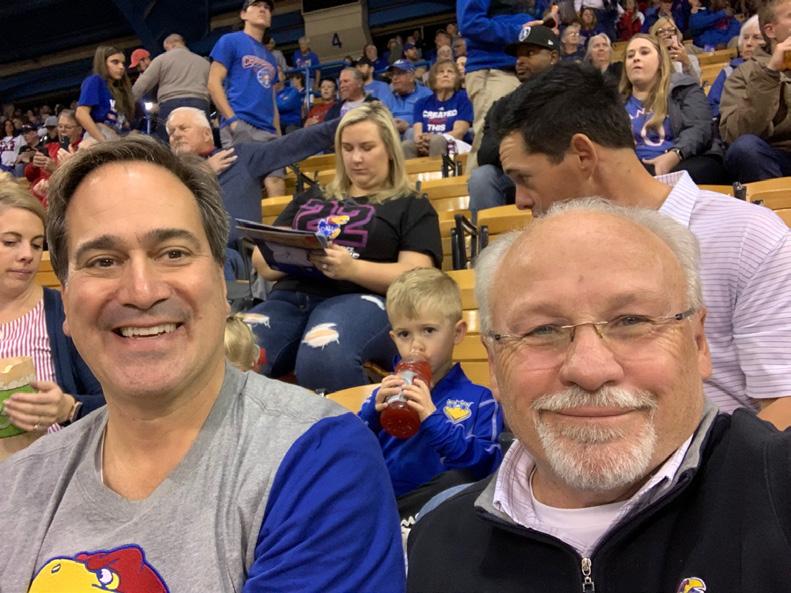
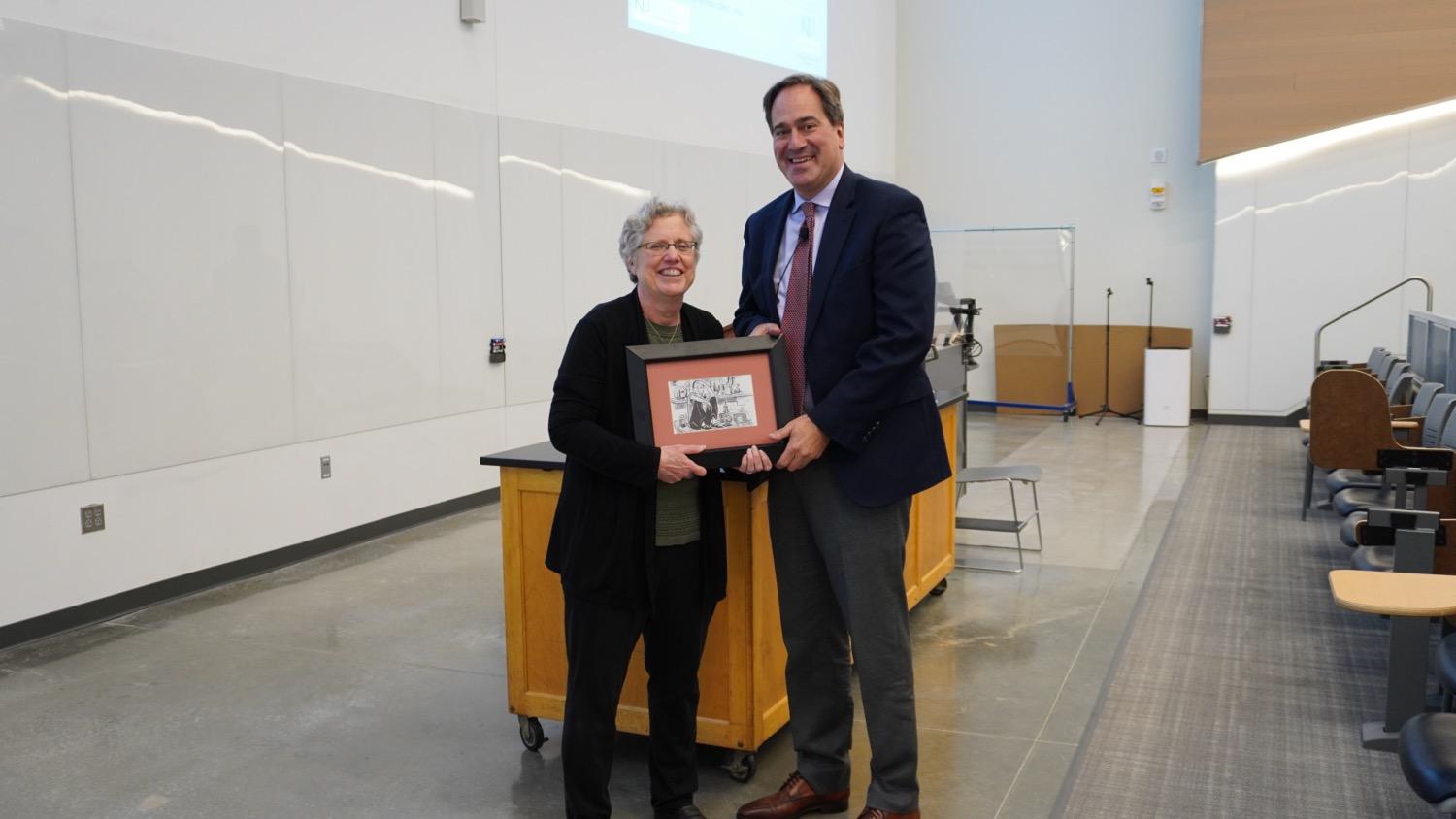
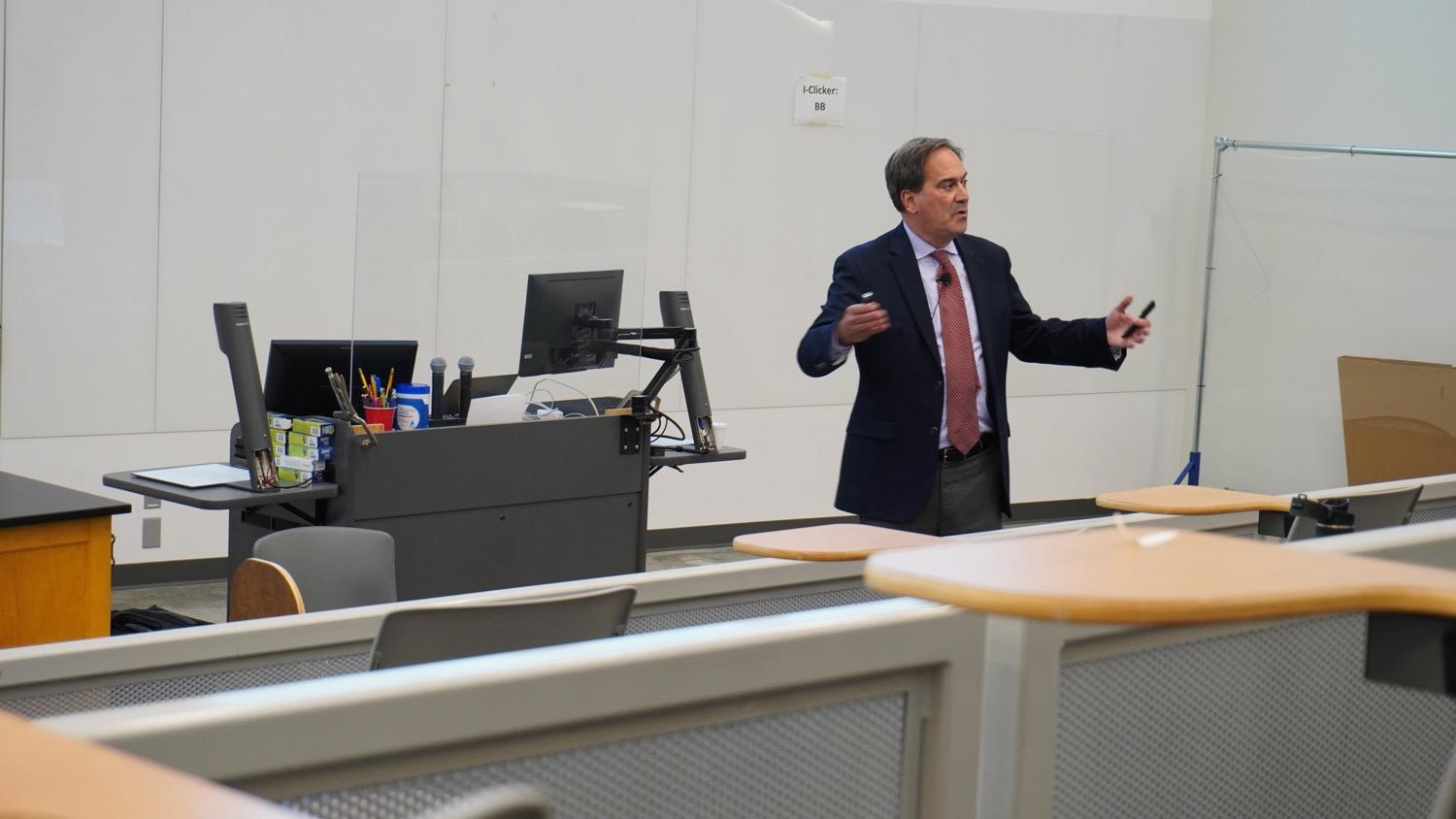

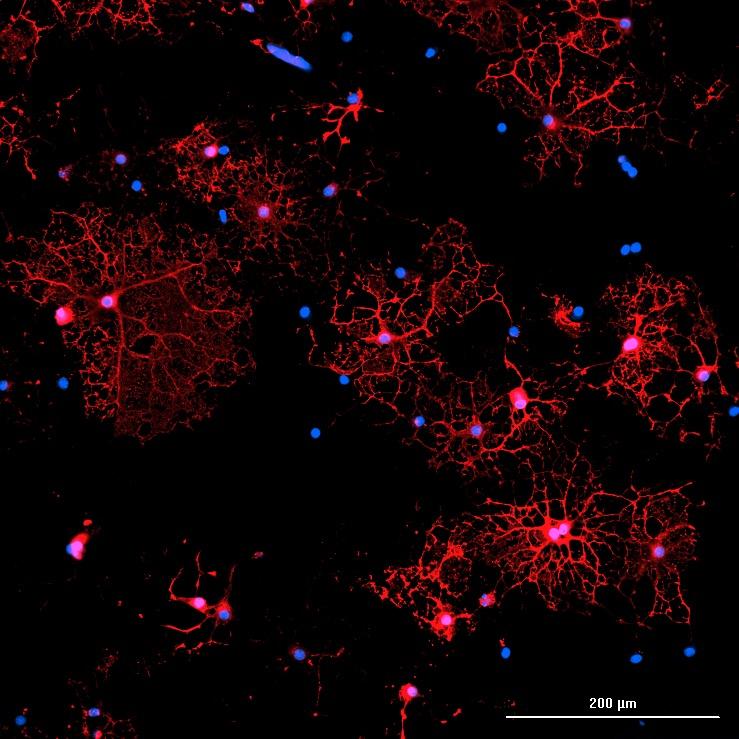
IOn Saturday April 9th, the faculty held an allday faculty retreat and strategic planning session at the Oread Hotel. This year we invited Wally Meyer from the Business School to act as the facilitator (pictured receiving a Jayhawk trophy from Bob


and methods to bear on chemistry. The morning was spent examining trends in data and discussing results from surveys sent to faculty prior to the meeting. In the afternoon, breakout sessions developed specific action items to adopt going forward. These are now being implemented to create a stronger and more effective program. As a sign of the collegiality within our department, even after a full day of “quality time” together, the faculty retreated to the rooftop of
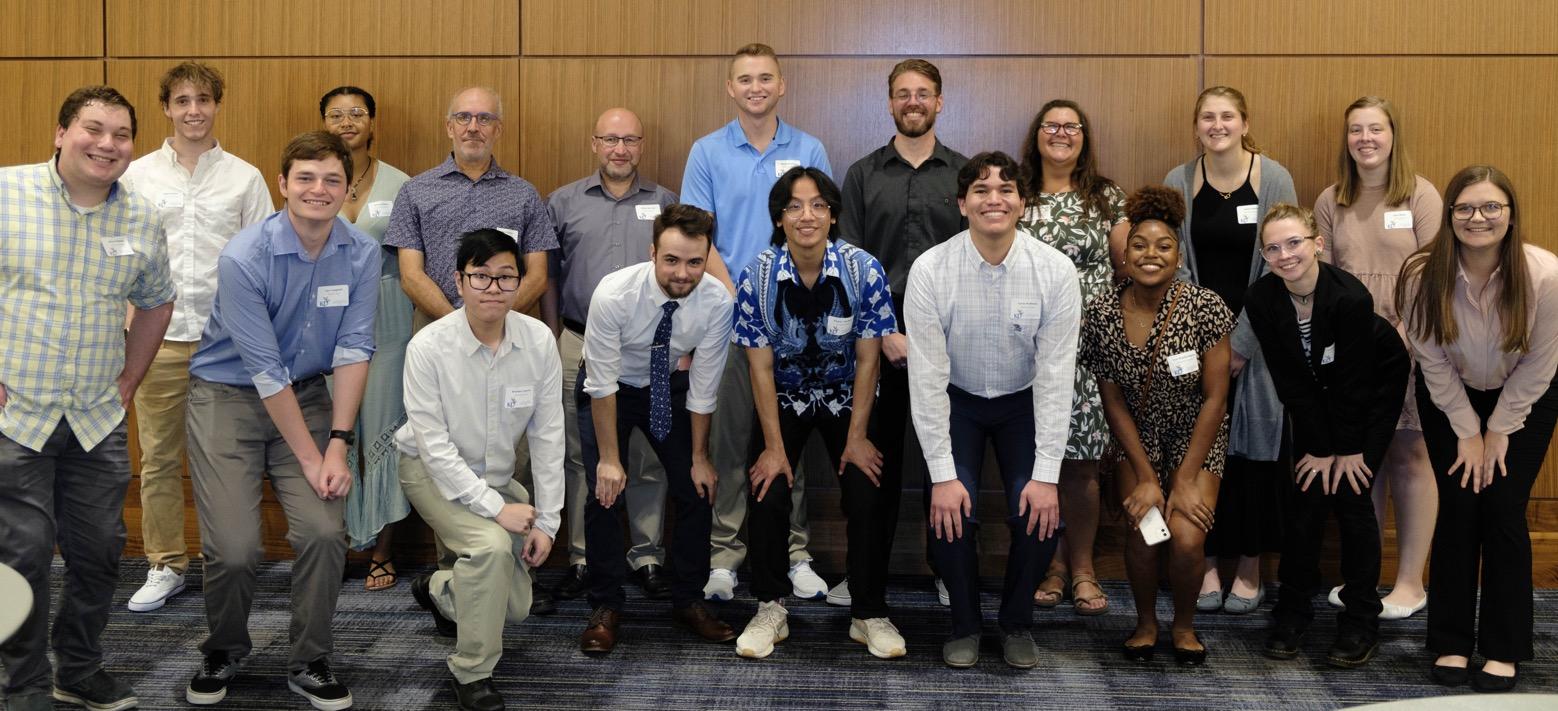
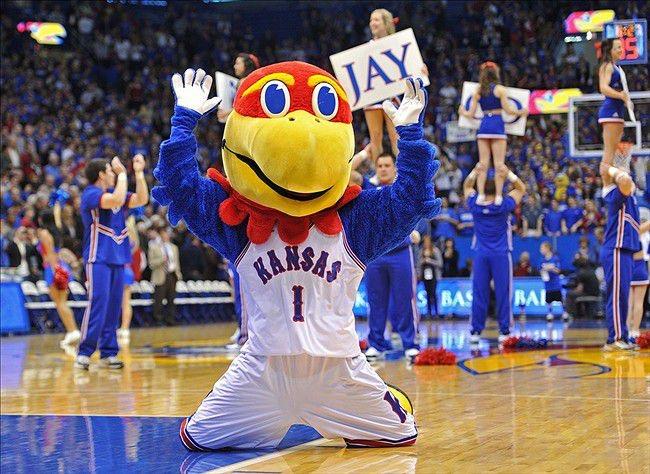
Chemistry NSF-REU Program brought ten students from Primarily Undergraduate Institutions around the country to KU for ten weeks of full-time chemistry research, professional development activities, and educational programming focused on sustainability. They were joined by five KU students, one supported by the NSFREU grant (Gavin Wolfmule), and two by Jack and Carolyn Landgrebe Summer Research Scholarships (Eleazar Abraham and Brian Faintich). Rounding out this outstanding cohort was Jamie Somers, a physics major at Dublin City University in Ireland, who participated by way of the KU/DCU Summer
Research Exchange Program (Riley Stegmaier was KU’s representative in this program).
Professional development and educational programming included two career panels (one focused on industry, the other on academia) and a tour of the Ralph Adams nanofabrication facility. We also maintained our focus on improving scientific communication skills, capped off in the final week by formal oral presentations and a campus-wide STEM poster session. More than half of the participants plan to present their research at the Spring 2023 ACS National Meeting or at Pittcon 2023. We sincerely hope that some will return to pursue their PhD at KU.
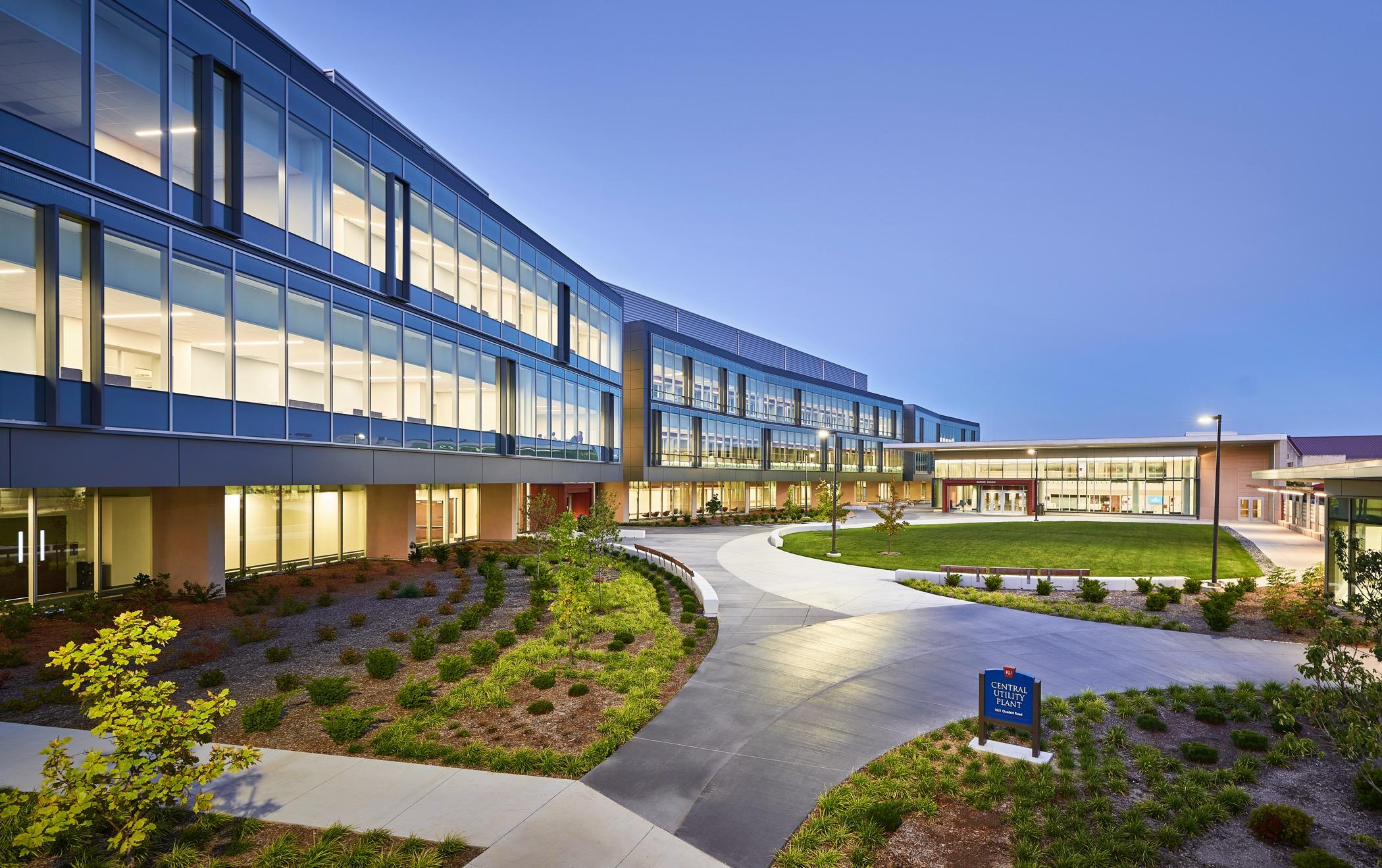
outstanding poster award at the Vibrational Spectroscopy Gordon Research Conference held at Bryant University in Smithfield, Rhode Island. Ashley presented her work examining the Hofmeister series, which ranks ions based on their effect on protein solubility, by simulating the infrared spectra of water in electrolyte solutions. Ashley was selected based on her poster and accompanying “1-minute poster pitch.”
he latest rankings of graduate programs from US News and World Report is out and Chemistry has significantly improved. Since the last survey in 2018, we climbed eight positions to 36th overall compared to other public universities. Other KU programs making the top 50 can be found here (https://news.ku.edu/ archive) by using the key words “top 50.” Compared to all universities, we improved 11 spots and are now ranked 62nd overall. Rankings are based “... solely on academic experts’ ratings” and our program will continue to climb as we expand our research and teaching missions.
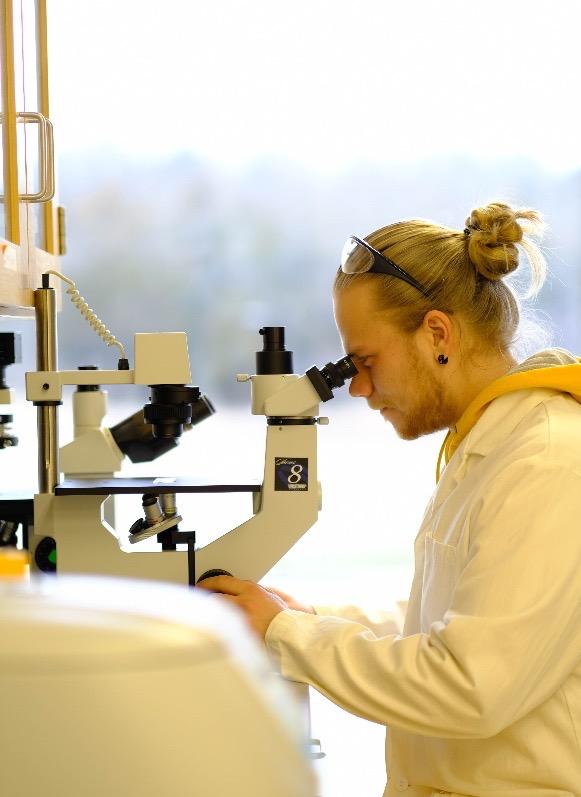
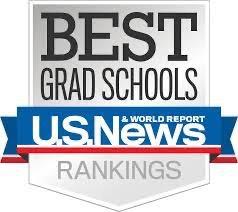
The walls of GrayLittle Hall are now adorned with posters from each chemistry research group advertising research opportunities for our undergraduates. Each poster uses the same general template and is printed on foam board so that the presentation of our posters matches the quality of our building! As seen above, poster boards highlighting the history of KU Chemistry are also mixed in. We have ones devoted to the disovery of helium and the origin of the rock chalk chant. We are currently completing one highlighting the career of Mary Elvira Weeksour first female Ph.D. and faculty member.

Congratulations to Chase Stucky in Prof. Mike Johnson’s group on his selection as our first Metrohm Summer Scholar. Metrohm is a leading manufacturer of analytical instrumentation (www.metrohm.com)and is generously sponsoring a graduate student as part of our Summer Scholars Program. Metrohm provided a generous stipend for Chase over the summer and has invited Chase to join them at Pittcon next year. Chase’s research is aimed at understanding the underlying roles of serotonin release and uptake in neurological disease states, including Alzheimer’s disease.
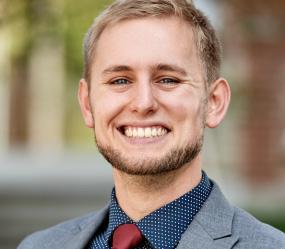
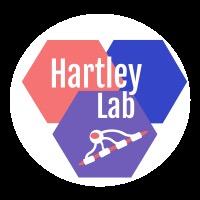
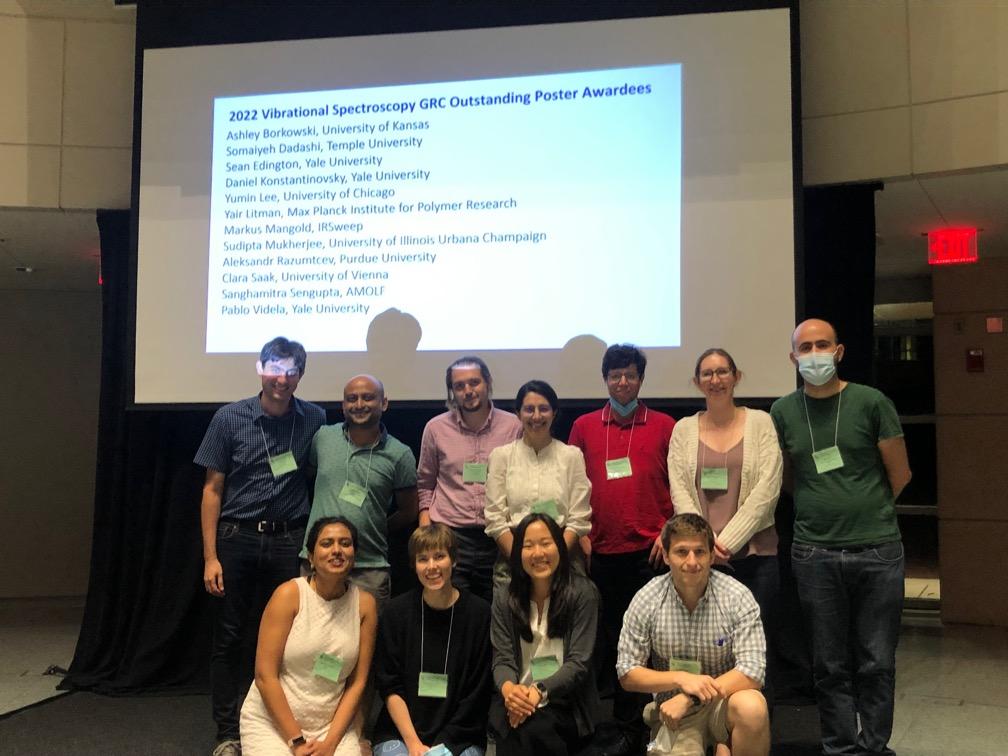

The Hartley Lab studies myelin, which is the fatty substance that wraps around nerve fibers in the brain and spinal cord. Myelin is critical for supporting healthy neurons by insulating axons during signal transduction. A major goal of the Hartley lab is to understand how the brain responds after myelin is damaged in diseases like multiple sclerosis. Matt Zupan (pictured), a fourthyear graduate student in the Hartley Lab, is particularly interested in the role of a lipid signaling molecule called
lysophosphatidic acid (LPA), which is known to induce myelination. To study how LPA acts in the brain, Matt is synthesizing novel, functionalized lipids that incorporate bioorthogonal chemical modifications. These include a photo-activatable crosslinker that covalently binds nearby proteins after light activation and an alkyne click chemistry handle that enables isolation of the LPA probe from complex cellular mixtures. The LPA lipid probe will be used in myelinating cells to identify which proteins are binding to LPA. At the Chemical Biology Symposium held at KU in October, Matt’s presentation on his LPA probe was named the Best Lightning Talk. Ultimately, with his research, Matt hopes to better understand how LPA promotes myelination and to use this information to develop more targeted therapies for multiple sclerosis and other diseases affected by myelin damage.

Targeted lipid probes of neuron myelination

Come one, come all – it’s the Carnival (of Chemistry)! As the first in-person Carnival of Chemistry since 2019, the return of this kid-focused event was nothing short of spectacular. The Carnival is an annual free celebration of science hosted by the Chemistry Department with activities geared toward kids in kindergarten through 8th grade, although all kids (and kids at heart) are welcome.




This year’s Carnival was held from 1 to 4 p.m. on Sunday, November 20th and offered more than 20 unique activities and demonstrations spanning three floors of Gray-Little Hall. The event had a focus on The Chemistry of Fabulous Fibers, but also had a healthy mix of chemistry, physics, engineering and geological science activities. We welcomed more than 600 attendees, most of whom enjoyed the event for 1 to 2 hours,



making their way from station to station. Examples of activities include no-touch putt-putt (electrostatics), cereal flake races (magnetic properties), oobleck (non-Newtonian fluids), slime (just fun!), CO2 bubbles and tie-dye butterflies.







“This Carnival was one of the best I have ever seen. It was very special to have such a success in both activities and attendance after taking a two-year break due to the pandemic.
We really brought it back in a grand way, and I hope we inspired some future chemists,” says Chair of the Department, Professor Robert Dunn. The success of this event would not have been possible without our 100+ volunteers. We recruited volunteers from our undergraduate and graduate student population, local high schools, KUMC respiratory therapist undergraduates, faculty, staff, and more.
Sayuri Niyangoda, a graduate student in the laboratory of Prof. Michael Johnson, won the Three Minute Thesis (3MT) competition. This competition gives students the opportunity to present their research in a way that engages



people who may not be experts in the field. Sayuri won both the overall and the people’s choice competitions with her speech, entitled “Alzheimer’s Disease through the Eyes of a Fish.” In her talk she articulated her research, which she is carrying out under the guidance of Dr. Romana Jarosova, Assistant Research Professor of Chemistry at KU, and Dr. Johnson. The awards come with a total $650 cash prize. She will represent KU in the regional 3MT competition, to be held in Chicago in March.
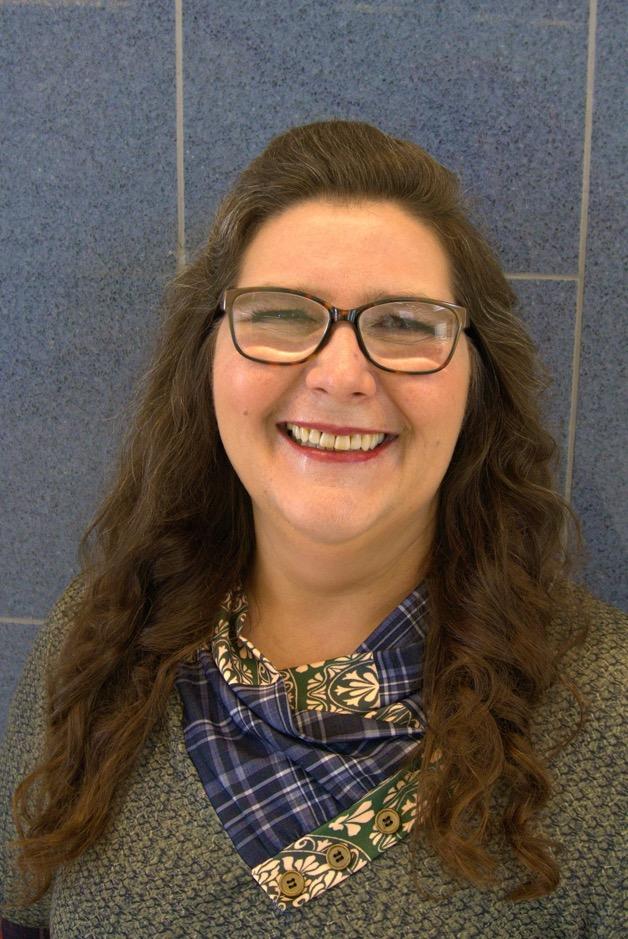

Stephanie Chamberlain joined the Chemistry Department in February 2022 after 9 years with KU Facilities Services and Campus Operations. She graduated from Avila University with a B.A. in Paralegal studies and implements her knowledge on compliance and regulatory issues. Stephanie has supported a wide variety of campus customers,
skilled trade shops, and managed the KU Vehicle Fleet with the State of Kansas. She provides general administrative support to the Chemistry Department and is the Program Administrator for the Chemistry REU Program. Stephanie has found it an incredible joy to work with students and looks forward to many more years to come!

hosted the graduate research opportunity weekend “GROW” for incoming graduate students. The ChemGSO sponsored snacks for prospective and current graduate students. To encourage student engagement and recognize their creativity, we announced our annual T-shirt design contest at the beginning of April. Rafael Hernandez had the winning design and it is avail-
able for $15. Please contact us if you are interested in buying one (https:// chem.ku.edu/chemgso). At the end of April, a baked goods fundraiser was organized which included a variety of baked goods from different cultures. This event raised $166.33 to support future networking events and was considered a huge success. In June, the Department welcomed the Summer 2022 REU students with a picnic. The ChemGSO took a lead role by arranging the food and organizing a volleyball game for the event. Later in July, the ChemGSO decided to expose students to a more international experience and the ChemGSO worked closely with the department to host a welcome picnic in August. Throughout the summer, the ChemGSO organized a seminar series presented by Nicole Reiz, the Director of Professional Development in the Office of Graduate Studies at KU. This excellent series covered topics
ranging from job searching and CV preparation, to career development. To finish the year, the ChemGSO threw a Halloween party and organized a poster session for new chemistry graduate and undergraduate students. If you would like to become more involved with our ChemGSO please contact us at kuchemgso@gmail.com and follow

Aug. 3, 1931 - Jan. 1, 2022
Professor Peter Hierl passed away on February 18, 2022, at the age of 80. Peter joined the faculty at KU in 1969 where he taught for 45 years before retiring in 2014. Peter is survived by his wife Janet; his children Julia and her husband Jeff, Emily, Erika (now deceased), Annie and her fiancé Brooks, Gretchen, and Ian; his grandchildren Ryan, Jeremy, Bryer, Tes, and Aaliyah; his brother and sister-in-law Thomas and Karyn; his in-laws Wally and Paula; his brother-in-law David; and his nieces and nephew Katrina, Alexander, Marina, and Suzanne. He was preceded in death by his children Katy and Michael, and his nephew Christopher. Peter was born in Brooklyn, New York, and he earned his undergraduate degree from MIT in 1963. He carried out his doctoral studies at Rice University, earning his Ph.D. in 1966. Following postdoctoral studies at Yale University and the University of Colorado, he began his independent career in the Department of Chemistry at KU in 1969. He remained at KU for his entire career where his research focused on the gas phase reactions of ions and molecules.


Peter liked to travel with his family and was especially fond of the Rocky Mountains. At home, he surrounded himself with his family and beloved dogs and cats. He enjoyed reading, especially American history, and was a gifted photographer. In the department, Peter was known for his collegiality, good humor, and dedication to teaching. He will be greatly missed.

Distinguished Professor Theodore “Ted” Kuwana passed away on January 1, 2022 at the age of 90 from complications due to pneumonia. Ted was a pioneer in the development of spectroelectrochemistry, leader in bioelectroanalytical chemistry, and founder of the Analytical Sciences Digital Library. He is survived by his wife Jane, son Eric, and daughter Ellen. Ted and Jane have four granddaughters: Claire, Camille, Mikka, and Kira.
Ted received his B.S. degree in chemistry from Antioch College in 1954 and his M.S. degree from Cornell University in 1956. He came to KU to study under the direction of Prof. Ralph N. Adams and became Ralph’s first Ph.D. awardee in 1959. Following postdoctoral studies with Prof. Fred Anson at the California Institute of Technology, he joined the faculty at the University of California, Riverside in 1960 as a Visiting Assistant Professor. He moved to Case Western Reserve as an Associate Professor in 1965 and was promoted to full Professor in 1968. In 1971 he moved to Ohio State University. Ted joined the faculty at KU in 1986 as Regents Distinguished Professor of Chemistry and Pharmaceutical Chemistry and Director of the Center for Bioanalytical Research. Ted published more than 200 journal articles, held three patents, and won numerous awards including the J. Calvin Giddings Award for Excellence in Education (2004). He trained over 70 graduate students using the often stated motto: “I’m not teaching chemistry, I’m teaching students how to think.”
Ted was tremendously influential in shaping our department and his philanthropic support in retirement helped us launch several new programs. In particular, he and Dr. Don Leedy initiated a fund that established the annual Ralph N. Adams Lectureship and supports graduate student travel to conferences. Ted was a friend and colleague who will be truly missed.
Department of Chemistry University of Kansas Room 1140, Gray-Little Hall 1567 Irving Hill Road Lawrence, KS 66045
The mission of Jayhawks Rising, KU’s strategic plan, is to educate leaders, build healthy communities and make discoveries that change the world. KU Chemistry is meeting each of these goals through our exceptional community of scholars, but we need your support to help us rise to this challenge. Scholarship support helps make a KU degree possible for students from underrepresented minority populations. Support for research advances great ideas and helps find an-

Gifts made by check should be payable to:
KU Endowment and mailed using the attached envelope or sent to:
Gift Processing Department
KU Endowment PO Box 928 Lawrence, KS 66044-0928
swers to complex questions. Faculty support provides a lift for those working hard to teach, mentor, and do research in an exceptionally difficult budget environment. We welcome your support of the department and appreciate your investment in KU Chemistry.
The easiest way to make a gift is to go to www.kuendowment.org/givenow. There will be a field for you to designate

that you’d like your gift to support KU Chemistry. If you’d like to know more about how you can make a difference in the lives of our students or faculty, contact Sheri Hamilton, Team Lead & Develop ment Director at KU En dowment (shamilton@ kuendowment.org or 785.832.7454).
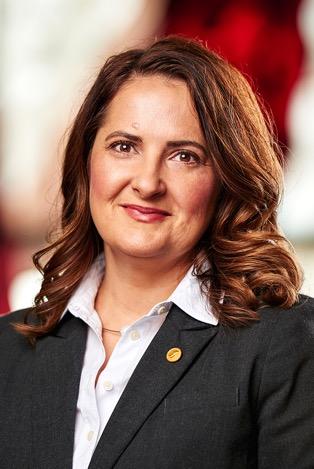
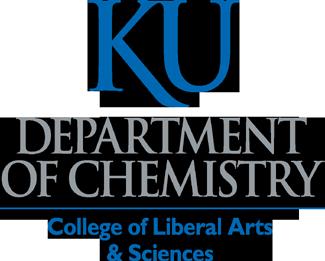
Thank you for your support and Rock Chalk!
You can give online at: chem.ku.edu/giving -orkuendowment.org/givenow
There will be fields that allow you to specify that your gift is to support Chemistry.
Give by Phone
Please call 785-830-7576
You will be asked for your credit card information and your gift’s purpose.